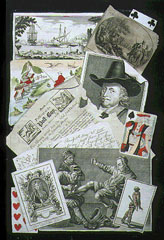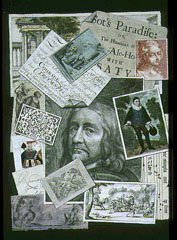|
The best account of Clarke's collection will be found in Clayton (1992). All the prints listed in the appendix to this article have been catalogued, together with 24 additional volumes and some folders of prints (see further below). Further illustrations will be found in Clayton (1997).
The collection is strong in ornament prints, prints of buildings and gardens and of antiquities, portrait prints especially of 17th and 18th-century figures, and prints after paintings, especially by Raphael and Poussin. There are also some satirical and ephemeral prints. Some quotations from Clayton (1992) follow:
 'The
core of the Roman collection consisted of 'art books' published by the
de Rossi and their imitators from the 1660s to the 1720s. Giovanni Giacomo
de Rossi recognized that cultivated visitors to Rome would buy books of
higher quality than those yet available, and he initiated a series of
ambitious publications. Clarke bought early issues of almost all the resulting
sets of prints engraved, for the most part, by Pietro Santi Bartoli. Indeed,
Clarke bought almost every authoritative modern text on vases, gems, coins,
lamps, inscriptions and any other relic of Classical civilization.'
'The
core of the Roman collection consisted of 'art books' published by the
de Rossi and their imitators from the 1660s to the 1720s. Giovanni Giacomo
de Rossi recognized that cultivated visitors to Rome would buy books of
higher quality than those yet available, and he initiated a series of
ambitious publications. Clarke bought early issues of almost all the resulting
sets of prints engraved, for the most part, by Pietro Santi Bartoli. Indeed,
Clarke bought almost every authoritative modern text on vases, gems, coins,
lamps, inscriptions and any other relic of Classical civilization.'
'The collection provided a complete and constantly updated visual account of contemporary Rome, conveyed by prints of sufficiently high quality to be themselves considered as objects of virtu, not mere documents.'
'If anything, the coverage of French design is even more intensive than of Italian, and again the prints embrace the full range of fine and applied arts, architecture, interior decoration, furniture design, garden design and the use of statuary and paintings. The collection is particularly rich in documentation of developments at Versailles.'
'In England Clarke's chief interest lay in public building at the universities and in London - the spheres of his own activities'
There are 'long sequences devoted to particular painters, notably Raphael, Poussin, Antoine Coypel and Salvator Rosa & In accordance with contemporary critical opinion Raphael's work was numerically dominant and was most determinedly sought out.'
'Clarke bought much of Hogarth's early work, an enthusiasm suggesting a new commitment to English painting and confirming Clarke's sensitivity, even in old age, to emerging talent. He collected a number of other early satires, including groups of plates about the Excise Crisis, the Famous Skreen and a pack of Bubble Cards published by Thomas Bowles and Emanuel Bowen.'
 'Clarke
was a dedicated patron of English engraving and encouraged most serious
undertakings, feeble though many still were by French standards. Simon
Gribelin, who engraved Clark's book-plate, became a particular favourite,
and Clarke acquired all Gribelin's historical engravings, several being
special impressions on vellum. He acquired most of Smith's subject prints
and some portraits, but made no attempt at an oeuvre collection like that
of Henry Aldrich. He bought Elisha Kirkall's innovative colour prints
of drawings, Gerard Vandergucht's historical sets of the Labours of Hercules
and Don Quixote, the twelve engravings of the life of Charles I published
by Bowles (c.1727) and Bernard Baron's set of 'good works' after Frans
Francken. As Vertue's admiring references to Clarke lead one to expect,
the collection is particularly rich in Vertue's prints.
'Clarke
was a dedicated patron of English engraving and encouraged most serious
undertakings, feeble though many still were by French standards. Simon
Gribelin, who engraved Clark's book-plate, became a particular favourite,
and Clarke acquired all Gribelin's historical engravings, several being
special impressions on vellum. He acquired most of Smith's subject prints
and some portraits, but made no attempt at an oeuvre collection like that
of Henry Aldrich. He bought Elisha Kirkall's innovative colour prints
of drawings, Gerard Vandergucht's historical sets of the Labours of Hercules
and Don Quixote, the twelve engravings of the life of Charles I published
by Bowles (c.1727) and Bernard Baron's set of 'good works' after Frans
Francken. As Vertue's admiring references to Clarke lead one to expect,
the collection is particularly rich in Vertue's prints.
For more detail view the appendix: full details of all 52 volumes